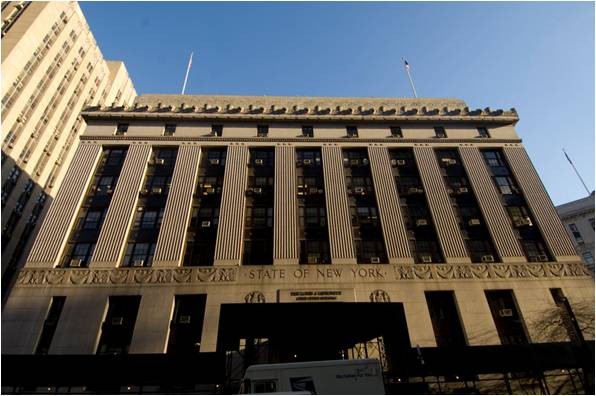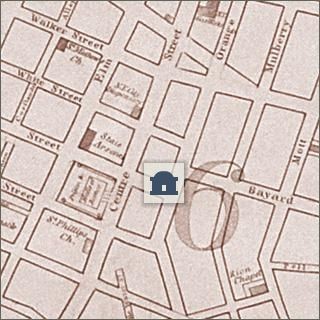African Society for Mutual Relief Hall (1834)
Introduction
Text-to-speech Audio
The African Society for Mutual relief was officially established at 42 Orange Street (modern day Baxter Street) during the 1820s, after Juliet Toussaint donated enough money for the Society to be able to buy the plot of land. The Society formed as soon it became legal for African-Americans residing in New York to organise. In 1810 the New York Legislature granted the Mutual Relief Societies the petition to become the first African American Association; this was a significant achievement as it was the first formal African-American establishment. Prior to the establishment of the African Society Mutual Relief Hall in 1808, the African-American community were deprived of several essential necessities such as education, religious commemorations, and even burial allowances. The community’s most vulnerable people, who included the sick, the widowed and the orphans suffered even more. The African Society for Mutual relief aimed to deal with the issues faced by the African-American community.
Images
View today of where the African Society of Mutual Relief Hall used to be

African Society for Mutual Relief location, New York, 1827

Backstory and Context
Text-to-speech Audio
The African Society for Mutual Relief was an organisation set up in New York City in the early 19th century. Although it is speculated that meetings took place before the official establishment, the main aim of this organisation was to provide critical support to African-Americans, this included helping its members with burial expenses, and providing insurance to the community. The organisation also intended to act as a safety net for those who were most vulnerable in the community; such as widows, orphans, and those who were sick, or disabled. One of the key figures of the Society was William Hamilton, who was a civil rights activist and an advocate for abolition of slavery. The African Society for Mutual Relief was a very important establishment in the early 19th century as it provided various different types of support in a time when African-Americans were significantly deprived and neglected of key essential necessities.
In the summer of 1834 tension was brewing between the abolitionists and the anti-abolitionists. The anti-slavery campaign evolved further after the British Parliament had passed the Slavery Abolition Act. During the riots in July, several important locations were targeted by anti-abolitionists, these include; Tappan’s properties, Bowery Theatre, Chatham Street Chapel, African Baptist Church, St. Philip’s African Episcopal Church, as well other shops, businesses, houses, the Five Points area was also greatly targeted.
The African Society for Mutual Relief Hall was one of the places that were attacked on 11th July 1834, rioters broke into the building smashed the windows and doors, caused damaged to the furniture, and left the Mutual Relief Hall’s interior completely wrecked. The structure itself had suffered a significant amount as a result of the riot in 1834. Although the society itself had lasted until the end of WWII, it relocated to a different location before the end of the 20th century as the threat from anti-abolitionists increased, and it was no longer a safe place to operate from.
The African Society for Mutual Relief is one of the crucial establishments for the African-American community, as without the relief that is provided; several of the vulnerable members would end up suffering horribly. Over the decades the original structure had been subject to damage as a result of the riots, as well as having stood through the WWII, however, despite having been remodelled, old remnants of the original meeting place of the Mutual Relief Hall exist today. The Mutual Relief Hall's location is considered to be now occupied by the Louis J. Lefkowitz Building on Baxter Street.
Sources
SULLIVAN, JAMES . THE NEW YORK AFRICAN SOCIETY FOR MUTUAL RELIEF (1808-1860), BLACK PAST. January 22nd, 2011. Accessed November 9th, 2022. https://www.Blackpast.org/african-american-history/new-york-african-society-mutual-relief-1808-1860/#:~:text=In%201808%2C%20the%20New%20York,house%20to%20buy%20real%20estate..
, Curriculum Concepts International. African Society for Mutual Relief, Mapping the African American Past. Accessed November 9th, 2022. https://maap.columbia.edu/place/25.html.
Harris, Leslie M. In the Shadow of Slavery: African Americans in New York City, 1626-1863. 2003.
Jaynes, Gerald D. Encyclopedia of African American Society, Volume 1. 2005.
Rushing, S Kittrell . Morris. Jr, Roy. Seeking a Voice: Images of Race and Gender in the 19th Century Press. 2009.
https://maap.columbia.edu/place/25.html
https://www.blackpast.org/african-american-history/new-york-african-society-mutual-relief-1808-1860/
